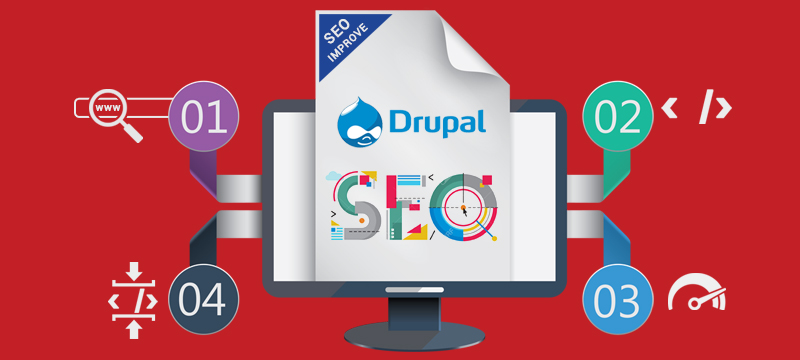Drupal is a powerful platform for building great websites but how do you get those websites to rank well on search engines? Unlike WordPress, which is relatively search engine friendly by design, Drupal needs a little more input when it comes straight out of the box. In this post, we’ll explain what steps you need to take to improve Drupal SEO and help your site rank higher in search engine results.
- Use clean URLs
One of the most important on-site SEO techniques is to include important keywords in the URLs of your website’s posts and pages. When looking for web pages to show in search results, search engines will specifically look at a URL for an indication of how relevant the content is to the searcher’s query.
Ideally, the URL should closely resemble the page’s title. So, if the page was called ‘Summer Holiday Outfits for Kids’ the URL should be ‘yourwebsite.com/summer-holiday-outfits-for-kids’. This way, the search engine would see both the title and the URL indicating that the page was relevant to someone’s search.
These types of URL are referred to as clean URLs. In WordPress, you can set up clean URLs very easily in the settings. With Drupal, however, you will need to install a module before this can take place. The module in question is the Pathauto Module.
On installation of Drupal, you may discover that your server cannot support clean URLs. This can happen if the server’s ‘mod-rewrite’ extension has been disabled. If this is the case, check out Drupal’s Clean URL page where help can be provided.
Once your server is set up to support clean URLs, you will then be able to install the Pathauto module and use it to create URLs that are based on page titles and are far more search engine friendly. - Using meta tags and meta descriptions
Drupal’s Metatag module enables you to add precise and relevant meta data to your website content. Meta data is used in two ways: firstly, search engine algorithms use it to determine the relevance of the page for a query and, secondly, the meta description is often shown in search results, enabling users to read the page content before visiting it.
What you write in the meta description can be the difference between your page being clicked on or ignored. If you don’t write a meta description, the search engine usually just pulls any random text from your web page that contains the user’s keywords. When you write your own, you can use it like a call to action to get the reader to click through to your website. Those who use this SEO technique find that click through rates can massively improve.
Importantly, the Metatag module lets you create individual meta tags for each page of your site, enabling search engines to judge each page’s relevance far more accurately. - Speed up for better ranking
Search engines have a dislike for slow loading websites as they offer a poor user experience, for this reason, they rank them lower. Consumers have the same opinion: according to Kissmetrics, 40% of users abandon a website that takes more than 3 seconds to load and a one second delay in loading drops conversion rates by 7%. With this in mind, the importance of speeding up your Drupal website cannot be underestimated.
Google is so concerned about slow loading websites that it has introduced a free speed test for webmasters. The PageSpeed Insights will tell you how well your site performs on both desktop and mobile devices, and it will produce a range of performance enhancing recommendations based on its analysis of your site. Testing your Drupal site using Google’s PageSpeed should be the starting point for this important area of SEO. If you are looking at more visitors from mobile phones than a PC then you should also consider building mobile pages using the AMP (Accelerated Mobile Pages) technology.
The technical areas that Google tool will look at include HTML, CSS and JS compression, image compression, and browser caching, all of which can be managed to improve loading speeds. The test also shows you issues with server response times, which is more difficult to remedy and highlights the importance of choosing dedicated Drupal hosting where servers are optimised for the Drupal platform.
Useful modules to help you improve any issues found during the Google PageSpeed test include the Views Content Cache and Boost. - Advanced script compression
When websites need to run a wide range of CSS and JS scripts to function properly in a browser, sending all the information in separate packets can significantly slow down the loading time. One way to overcome this is through CSS and JavaScript compression. By configuring the AdvAgg Module, you can compress Drupal’s CSS and JavaScript or you can also use the module Speedy to replace Drupal’s core JS files with compressed alternatives. Both of these can bring improvements to loading times and lead to better search engine rankings.
Conclusion
From reading this post, you will now have a better understanding of how you can improve SEO for Drupal in regard to URLs, meta tags and meta descriptions, loading times and advanced compression. These more technical aspects of your SEO can have a big impact on your ranking. Do remember that you will also need to focus on your on-page SEO (keywords in content, etc.) and off-site SEO (external links, social media likes, etc.).
If you are considering dedicated Drupal hosting for your website, take a look at our Drupal hosting packages. We’ll even take care of the migration for you – for free.

